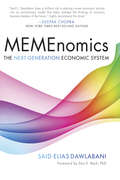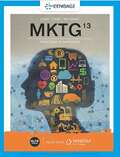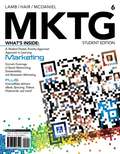- Table View
- List View
MEMEnomics
by Said Elias DawlabaniMEMEnomics -- \MEE - MEH -nomics\ -nounA new branch of social science that studies patterns of economic policies and practices by taking an integral, whole-systems approach to economic sustainability. The term "vMEME" (the superscript "v" is for "value") refers to a core value system expressed through a culture's memes, i. e. , its ideas, habits, and cultural preferences and practices that spread from person to person. In MEMEnomics Said E. Dawlabani reframes our economic history and the future of capitalism through the unique prism of a culture's value systems. Focusing on the long-term effects of economic policies on society, he expands psychologist Clare W. Graves' concepts of the hierarchical nature of human development and the theories of value systems of Beck and Cowan's Spiral Dynamics. He presents our economic history in terms of the hierarchy of five of the eight value-systems or vMEMEs of human existence that we can now identify. These new value preferences emerge as people interact with their environment to solve the problems of their "life conditions. " The author believes that the pattern of economic cycles resulting from cultural value systems is critical to understanding the evolution of the meme of laissez-faire capitalism. By demonstrating predictable cycles of our economic history through the spiral of evolving levels of cultural value systems, he argues for the need to change the course of failures inherent in our current system. Mr. Dawlabani then offers a solution to the viability of capitalism-the formation of a "smart model" of government designed from the values of the currently emerging seventh-level value system. Mr. Dawlabani calls on business leaders to evolve their values to the higher seventh-level system detailed in his "platform of functional capitalism. " In this evolution of business consciousness, humanity moves from the myopic ethic of "subsistence" to a new frontier that champions the emerging ethic of the "magnificence of existence"-where we will all blend as part of a larger, compassionate whole.
MEMEnomics: The Next-Generation Economic System
by Said Elias Dawlabani Don E. BeckThe term "vMEME" (the superscript "v" is for "value") refers to a core value system expressed through a culture's memes, i.e., its ideas, habits, and cultural preferences and practices that spread from person to person. In MEMEnomics Said E. Dawlabani reframes our economic history and the future of capitalism through the unique prism of a culture's value systems. Focusing on the long-term effects of economic policies on society, he expands psychologist Clare W. Graves' concepts of the hierarchical nature of human development and the theories of value systems of Beck and Cowan's Spiral Dynamics. He presents our economic history in terms of the hierarchy of five of the eight value-systems or vMEMEs of human existence that we can now identify. These new value preferences emerge as people interact with their environment to solve the problems of their "life conditions."
MESH – Die Evolution der Zusammenarbeit: Warum vernetzte Kompetenz mehr ist als bloße Kooperation
by Christoph ZulehnerDieses Buch beschreibt eine neue Welt der Zusammenarbeit. Ihre große Chance besteht im Teilen von Wissen innerhalb eines Netzwerks aus kooperierenden Spezialisten, dem MESH. Dabei geht es um weit mehr als klassische Arbeitsteilung. MESH ist nicht weniger als ein nächster Schritt in einem evolutionären Prozess. Indem menschliche Spezialisten ihre Gehirne ko-kreativ zusammen„schalten“, entsteht ein neuartiges, kollektives Bewusstsein, das allen arbeitenden Menschen ermöglicht, über sich hinauszuwachsen und die drängenden Herausforderungen des 21. Jahrhunderts gemeinsam zu meistern.
MF Staff Country Reports
by International Monatry FundA report from the International Monetary Fund.
MGMT
by Chuck WilliamsThrough ongoing research into students’ workflows and preferences, MGMT from 4LTR Press combines an easy-reference textbook with Chapter Review Cards and an innovative online experience--all at an affordable price. MGMT continues to make concepts and theories accessible and relevant to students with timely, interesting examples of their applications at real businesses. MindTap is the digital learning solution that powers students to think and act like managers. It gives you complete control of your course--to provide engaging content, to challenge every individual and to build their confidence. MGMT continues to make concepts and theories accessible and relevant to students with timely, interesting examples of their applications at real businesses. MindTap for MGMT has been reimagined to best meet the needs and workflow of students -- helping them to think and act like managers. MindTap for MGMT progresses from basic conceptual understanding in the Learn It activities to applications in the Apply It folder's more scenario-based Chapter Assignments and scenario-based Case Activities.
MGMT 8 - Principles of Management
by Chuck WilliamsMaster storyteller, award-winning educator, and accomplished author Chuck Williams uses a captivating narrative style to illuminate today's most important management concepts and practices that really work in today's workplace. To keep the information personally relevant, Dr. Williams weaves more than 50 unforgettable examples and stories into each chapter in this edition. Proven learning features and self-assessments keep concepts intriguing and applicable to students' daily lives. As this edition's fresh scenarios, new cases, and new video cases reflect the latest management innovations at work in well-known organizations throughout the world, readers gain a better understanding of what they need to ensure managerial success.
MGMT4 (2011 Student Edition)
by Chuck WilliamsStudent-tested and faculty-approved, MGMT4 2011 EDITION offers an innovative approach to teaching principles of management. This paperback provides a complete suite of fresh learning aids to accommodate the busy and diverse lifestyles of today's learners, including downloadable flashcards, videos, MP3 review podcasts, and quick quizzes that allow students to study wherever they are and whenever they have time. Designed to reach today's students, MGMT says it all in four letters, reflecting how this unique solution speaks in the language of today's learner. MGMT4 started with student conversations, focus groups, interviews, surveys, and input from nearly 150 faculty members like you. This innovative approach unites today's latest management research with author Chuck Williams' unique storytelling approach in a visually rich, yet professional, design that reads like a business periodical. MGMT4 provides a streamlined, concepts-driven format with optional exercises, new cases, and new practical applications that you can choose to use depending on your students' needs. MGMT4 2011 EDITION offers the engaging principles of management solution that you and your students have created together.
MGNREGA: Employment, Wages And Migration In Rural India
by Parmod Kumar Dipanwita ChakrabortyThe Mahatma Gandhi National Rural Employment Guarantee Act (MGNREGA) was enacted in India with the multiple objectives of providing employment in a rights-based framework, addressing rural poverty, checking migration, and building rural infrastructure. As such, every year around 15–20 per cent of households in India overall and 30 per cent in rural India receive some form of employment share under the MGNREGA programme. This volume looks at various aspect of the scheme, its linkage with employment, agricultural wages, livelihood and food security, gender issues, and migration in rural India. It also discusses challenges in implementation, hurdles and the relative successes of the scheme. Based on primary survey data from 16 major states in the country, the findings of the study provide key insights into MGNREGA and assess the implications for other welfare-oriented programmes. Rich in empirical data, this volume will be useful to scholars and researchers of political economy, economics, agriculture, rural development and sociology, as well as policymakers and nongovernmental organisations.
MIA: Profit at the Base of the Pyramid
by Aldo Sesia Lynda M. Applegate Sarah Mehta Jose Antonio Davila CastillaIn January 2016, Guillermo Jaime had just returned home to Mexico City after attending a Harvard Business School executive education program. Jaime was the founder and CEO of Mejoramiento Integral Asistido (MIA), a company providing affordable housing to low-income Mexicans living at the base of the pyramid (BOP), defined as those living on less than $10 per day. Since its launch in 2009, MIA had built nearly 25,000 homes-which provided safe shelter to more than 100,000 Mexicans-while generating an earnings before interest, taxes, depreciation, and amortization (EBITDA) margin of over 8%. At the executive education program, Jaime had learned that entrepreneurs could build on their unique attributes and capabilities to expand and grow their businesses. Should he continue to expand the services MIA offered to BOP customers? Could he leverage what made MIA unique-offering affordable homes for its BOP customers in Mexico-to fulfill other critical needs at the BOP for water, clean energy, and health care services? Jaime was an expert in housing, but could he translate that expertise to such diverse sectors? If so, how should he begin?
MICHAł KALECKI IN THE 21ST CENTURY
by Jan Toporowski Łukasz MamicaLeading experts on Kalecki have contributed special essays on what economists in the 21st century have to learn from the theories of Kalecki. Authors include surviving students of Kalecki, such as Amit Bhaduri, Mario Nuti, Kazimierz Laski Jerzy Osiatynski, and Post-Keynesian economists such as Geoff Harcourt, Marc Lavoie, and Malcolm Sawyer.
MIDAS Technical Analysis: A VWAP Approach to Trading and Investing in Today's Markets (Bloomberg Financial #148)
by Andrew Coles David HawkinsThis book provides a new, powerful twist to MIDAS technical analysis, a trading method developed by the late Paul Levine. The authors show how to employ MIDAS in trading, from recognizing set ups to identifying price targets. The book explains the basics of MIDAS before demonstrating how to apply it in different time frames. Further, it extrapolates how MIDAS can be used with other more conventional indicators, such as DeMark or moving averages. In addition to introducing new indicators that the authors have created, the book also supplies new computer codes.
MINI USA: Finding a New Advertising Agency (A)
by David B. GodesSelling an intangible like advertising services is a difficult task. The first step is to understand how brands buy these services. What are they looking for? What do they need to learn? How do they go about assessing things like creativity, trust, and loyalty? This set of cases puts the students into the roles of the seller (an advertising agency named Butler, Shine, Stern and partners) and the buyer (MINI USA) and asks them to develop a sales strategy for advertising services. As outlined in the (B) case, the agency developed an intriguing and original approach to assessing the intangibles and students are asked to react to it from a sales perspective and to attempt to generalize the approach to other sales domains.
MINTing Innovation at NewYork-Presbyterian (A)
by David Kiron Richard G. HamermeshSeveral top surgeons at NewYork-Presbyterian hospital (NYP) are receiving financial and administrative support to advance their surgical device inventions through the earliest stages of commercialization.
MINTing Innovation at NewYork-Presbyterian (B)
by Michael Norris Richard G. HamermeshThis short (B) case gives an update on the progess that MINT has made at NYP since the end of the (A) case.
MIS
by Hossein BidgoliLearn the principles of MIS as you explore the latest developments and industry trends with MIS 10. This practically focused approach helps you master foundational MIS concepts that will guide your career. You examine the latest topics, such as cloud computing, AR/VR, quantum computing and blockchain, with the most current MIS title on the market. Have you ever wondered what you would have done as a company leader in a critical moment? With this edition's MindTap digital experience, you can strengthen your decision-making skills with "YouDecide" -- new interactive case studies that bridge technology and business strategy and position you as the decision maker.
MIT Mystery Hunt: The Answer is Secondary
by Willy Shih Karen RobinsonThe MIT Mystery Hunt is an annual puzzle-based scavenger hunt at MIT. It is run every year by a different team, and every year is slightly different as teams try new ideas and decide whether to keep or ignore new ideas from previous years. As the Mystery Hunt has grown, organizers face the challenge of balancing efficient administration while keeping it free of excessive administration.
MIT and the Rise of Entrepreneurial Science (Routledge Studies In Global Competition Ser. #12)
by Henry EtzkowitzMIT and the Rise of Entrepreneurial Science is a timely and authoritative book that analyses the transformation of the university's role in society as an expanded one involving economic and social development as well as teaching and research. The Massachusetts Institute of Technology invented the format for university-industry relations that has be
MITI and the Japanese Miracle: The Growth of Industrial Policy, 1925-1975
by Chalmers JohnsonThe focus of this book is on the Japanese economic bureaucracy, particularly on the famous Ministry of International Trade and Industry (MITI), as the leading state actor in the economy. Although MITI was not the only important agent affecting the economy, nor was the state as a whole always predominant, I do not want to be overly modest about the importance of this subject. The particular speed, form, and consequences of Japanese economic growth are not intelligible without reference to the contributions of MITI. Collaboration between the state and big business has long been acknowledged as the defining characteristic of the Japanese economic system, but for too long the state's role in this collaboration has been either condemned as overweening or dismissed as merely supportive, without anyone's ever analyzing the matter. The history of MITI is central to the economic and political history of modern Japan. Equally important, however, the methods and achievements of the Japanese economic bureaucracy are central to the continuing debate between advocates of the communist-type command economies and advocates of the Western-type mixed market economies. The fully bureaucratized command economies misallocate resources and stifle initiative; in order to function at all, they must lock up their populations behind iron curtains or other more or less impermeable barriers. The mixed market economies struggle to find ways to intrude politically determined priorities into their market systems without catching a bad case of the "English disease" or being frustrated by the American-type legal sprawl. The Japanese, of course, do not have all the answers. But given the fact that virtually all solutions to any of the critical problems of the late twentieth century--energy supply, environmental protection, technological innovation, and so forth--involve an expansion of official bureaucracy, the particular Japanese priorities and procedures are instructive. At the very least they should forewarn a foreign observer that the Japanese achievements were not won without a price being paid.
MK Taxi: Private Chauffeur Service
by Andrew McafeeMK Taxi Tokyo has developed a system to allow customers to use their mobile phones to find and contact the cab closest to them, bypassing the dispatch center. The system, called the Private Chauffeur Service (PCS), makes use of NTT's i-mode service, which essentially turns mobile phones into small Internet terminals. MK worked with NTT to develop an application that physically locates each PCS caller, determines the closest cab, and automatically connects the customer with the cab's driver for a voice call. At the time of the case, Maasaki Aoki, the head of MK Tokyo, wonders how best to expand and enhance the PCS service.
MKTG
by Charles W. Lamb Joe F. Hair Carl McDanielLearn Marketing YOUR Way with MKTG! MKTG's easy-reference, paperback textbook presents course content through visually-engaging chapters as well as Chapter Review Cards that consolidate the best review material into a ready-made study tool. With the textbook or on its own, MKTG MindTap allows you to learn on your terms. Read or listen to textbooks and study with the aid of instructor notifications, flashcards and practice quizzes. Track your scores and stay motivated toward your goals. Whether you have more work to do or are ahead of the curve, you'll know where you need to focus your efforts.
MKTG (Mindtap Course List Series)
by Charles W. Lamb Joe F. Hair Carl McDanielMKTG from 4LTR Press connects students to the principles of marketing, bringing them to life through timely examples showing how they're applied at the world's top companies every day.
MKTG 7 (Marketing, 7th Edition)
by Carl Mcdaniel Charles W. Lamb Joseph F. HairThe book is introduces students to the world of Marketing and elaborates on market opportunities, product decisions, promotions etc.
MKTG Principles of Marketing (9th Edition)
by Carl Mcdaniel Charles W. Lamb Joseph F. HairMKTG 9 offers full coverage of course concepts through unique resources and features that reflect the natural study habits of students, accompanied by straightforward assignment options for instructors.
MKTG6
by Carl Mcdaniel Charles W. Lamb Joe F. HairCreated through a "student-tested, faculty-approved" review process with direct input from students and faculty, *MKTG6* is an engaging and accessible solution to accommodate the diverse lifestyles of today's learners. *MKTG6* employs up-to-date, relevant examples from a wide range of independent upstarts and larger companies students love. *MKTG6* also offers a dynamic range of web-based review and testing products to facilitate today's on-the-go lifestyle.















